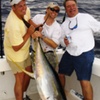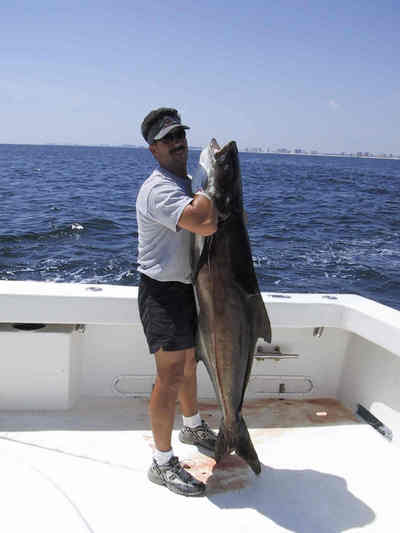The cobia should start showing-up about the middle of March, and usually anglers will catch some pretty-big fish at the beginning of the run. We've noticed over the years that when we have really-cold winters like we've had this year in the Alabama Gulf Coast area, we'll often have a larger migration of cobia running just off the Alabama Gulf Coast than usual. So, this year we're expecting to see and catch a lot of cobia. To catch the cobia, we move up and down the beach at almost-idle speed, trying to see the cobia to cast to them. The cobia can be as close as 1/2-mile or 4 to 5 miles off the beach. We'll run a zigzag pattern, look for the fish and try to identify a thermocline (a temperature change in the water either on or under the surface). The cobia will tend to follow changes in the water temperature and water clarity. Ideal conditions will be when this area has a southeast wind and clear water, so we can see the fish.
Once we spot the cobia, I'll try to get the boat into position so my anglers can cast to the cobia. We like to start-off fishing with live eels from the boat's live well. When we start looking for cobia, we'll hook-up one of the eels, place it in a 5-gallon bucket and put some ice in the bucket with the eel to bring the water's temperature in the bucket down. When we see a cobia and cast that cold eel out into the warm waters of the Gulf, the eel will really put on a show for the cobia and entice the big fish to eat it. If the cobia won't take the live eel, we usually have a large live pinfish or a croaker ready to cast to the cobia. If the live bait doesn't produce a strike from the cobia, we have big cobia jigs we can cast to the fish on spinning tackle to try to get the cobia to bite.
Oftentimes we'll only see one or two cobia in a day of fishing, but we may see as many as 15 or 20. The best day I've ever had in March was one year when we saw 30 fish, cast to 20 and caught and released eight. The biggest cobia we've ever caught off my boat weighed 99 pounds and 6 ounces. Through the years, we've caught four cobia that weighed 90 pounds or more each, but we've never caught a 100-pound cobia. I believe that 2009 will be the year I'll break that 100-pound mark for cobia.
One of the advantages of cobia fishing is we can catch other species of fish, while we're looking for cobia. While moving along the beaches hunting those big brown fish, we can be pulling baits for Spanish mackerel and redfish. Many times I have families who come down in March and want to go fishing. So, we'll troll for Spanish mackerel and redfish along the beach while we're looking for cobia. When we spot a cobia, we'll pull-in our trolling rods and position the boat to cast to the cobia. Once we catch or spook a cobia, we'll once again start trolling for Spanish and king mackerel. We make sure our customers have plenty of action when we go cobia fishing.
Another advantage this year is we've made two changes in our pricing and the length of our trips because of the economy and better fuel prices. We'll run 4-hour cobia trips for a family of four for $500, and we can take two, 4-hour trips in a day. We realize that many families with small children don't want to fish all day long and may not have enough money to book an all-day trip. So, we've tried to make our trips more affordable and shorter who want to go on an adventure and fish for Cobia and Spanish Mackerel. Text by John Phillips


